Why Chinese Zodiac Animals Matter for Your Personal Journey
Chinese zodiac animals represent a 2,000-year-old system that assigns one of 12 animals to each year in a repeating cycle. This ancient wisdom connects your birth year to specific personality traits, compatibility patterns, and life insights.
The 12 Chinese Zodiac Animals (in order):
- Rat – Clever, adaptable, resourceful
- Ox – Reliable, determined, honest
- Tiger – Brave, confident, competitive
- Rabbit – Gentle, quiet, neat
- Dragon – Lucky, flexible, eccentric
- Snake – Wise, intuitive, graceful
- Horse – Animated, active, energetic
- Goat – Calm, gentle, sympathetic
- Monkey – Sharp, smart, curious
- Rooster – Observant, hardworking, courageous
- Dog – Lovely, honest, responsible
- Pig – Compassionate, generous, diligent
Your zodiac animal influences more than just personality – it affects compatibility with others, career strengths, and even which years might bring challenges or opportunities. The system goes deeper too, incorporating five elements (Wood, Fire, Earth, Metal, Water) that create a 60-year cycle of unique combinations.
Understanding your Chinese zodiac animal offers practical insights for relationships, career choices, and personal growth. Unlike Western astrology based on birth months, this system uses birth years and connects to the lunar calendar, making it especially relevant for major life decisions and timing.
I’m Oracle, and I’ve spent years studying how chinese zodiac animals influence personality patterns and life paths through numerological and astrological frameworks. My experience with Eastern wisdom traditions helps people find meaningful connections between their zodiac traits and personal development goals.
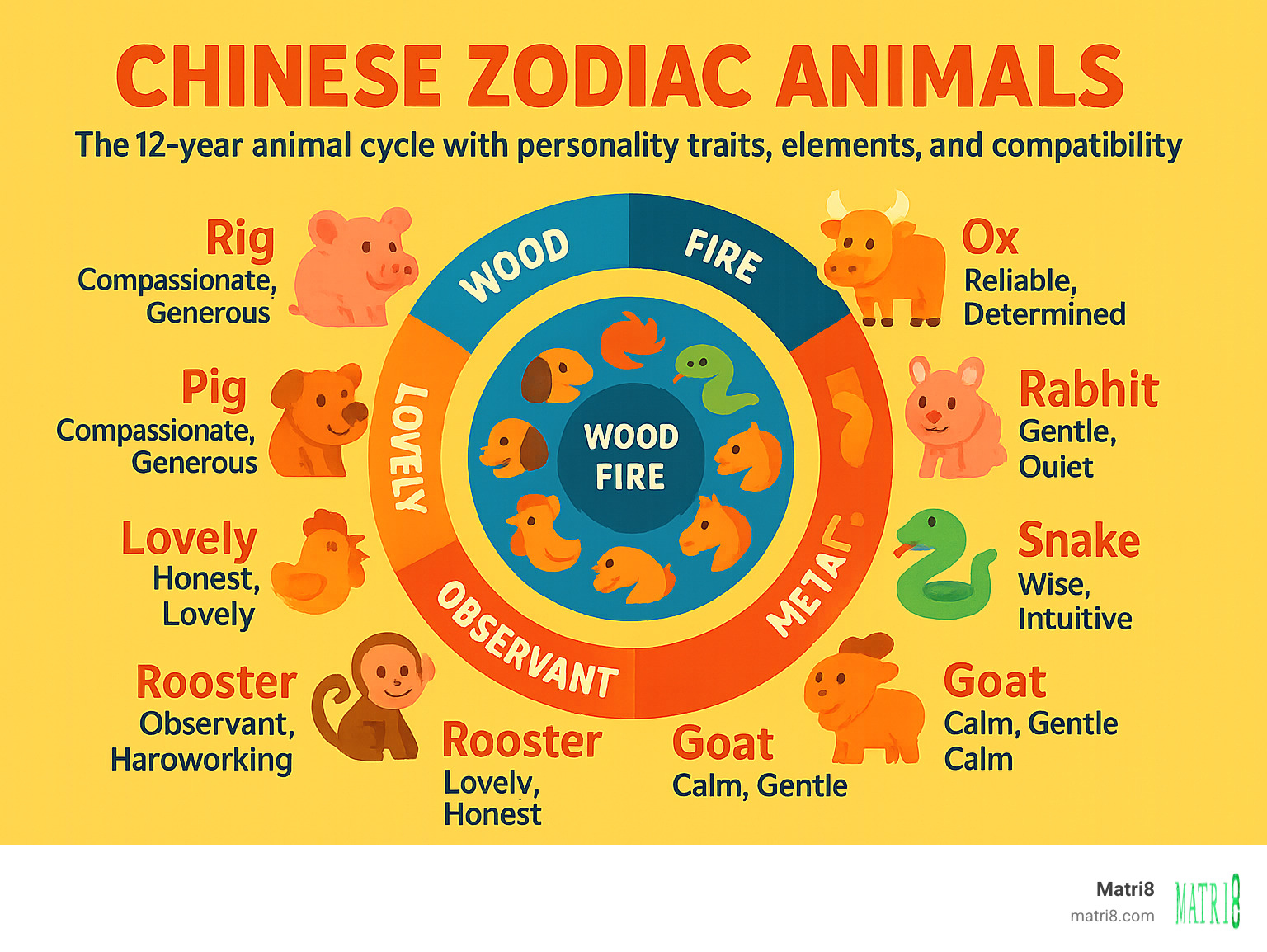
Chinese zodiac animals terms made easy:
Meet the Chinese Zodiac Animals
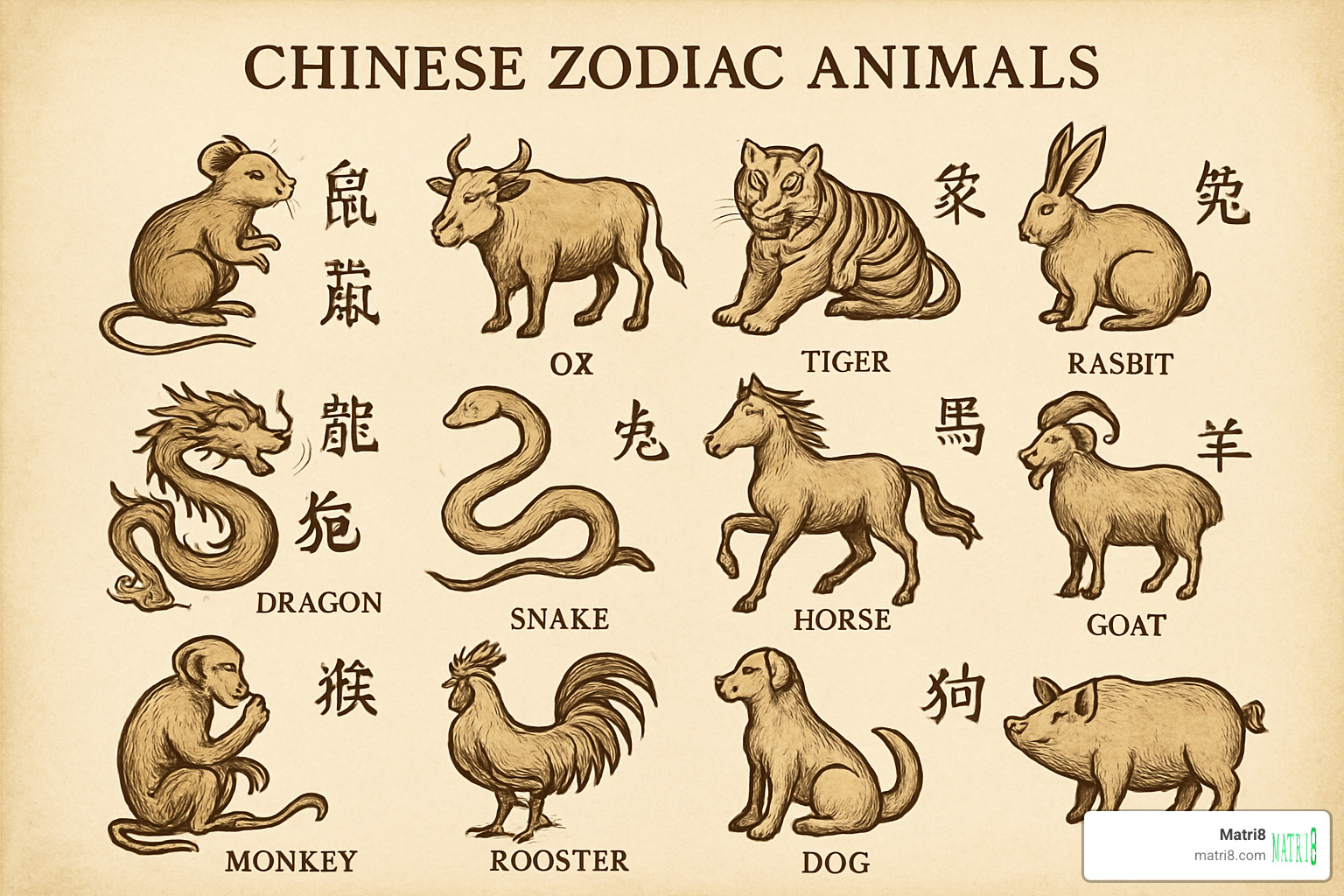
The Chinese zodiac animals follow a specific order that comes from ancient legend, but there’s actually a practical reason behind the 12-year cycle. Ancient Chinese astronomers noticed that Jupiter takes approximately 12 years to orbit the sun, which became the foundation for this system. The animals were later added as memorable symbols to help people remember the complex calendar system.
What makes this fascinating is how deeply the zodiac is woven into daily life. Each animal represents not just a year, but also specific hours of the day. People would reference “Dog hours” (7-9 PM) or “Dragon hours” (7-9 AM) in conversation, making the zodiac a living part of timekeeping.
Chinese Zodiac Animals Quick List
Understanding your Chinese zodiac animals means knowing more than just your birth year. Each animal governs specific hours and carries unique elemental properties that influence personality traits.
| Animal | Recent Years | Hours | Yin/Yang | Fixed Element |
|---|---|---|---|---|
| Rat | 1996, 2008, 2020 | 11pm-1am | Yang | Water |
| Ox | 1997, 2009, 2021 | 1am-3am | Yin | Earth |
| Tiger | 1998, 2010, 2022 | 3am-5am | Yang | Wood |
| Rabbit | 1999, 2011, 2023 | 5am-7am | Yin | Wood |
| Dragon | 2000, 2012, 2024 | 7am-9am | Yang | Earth |
| Snake | 2001, 2013, 2025 | 9am-11am | Yin | Fire |
| Horse | 2002, 2014, 2026 | 11am-1pm | Yang | Fire |
| Goat | 2003, 2015, 2027 | 1pm-3pm | Yin | Earth |
| Monkey | 2004, 2016, 2028 | 3pm-5pm | Yang | Metal |
| Rooster | 2005, 2017, 2029 | 5pm-7pm | Yin | Metal |
| Dog | 2006, 2018, 2030 | 7pm-9pm | Yang | Earth |
| Pig | 2007, 2019, 2031 | 9pm-11pm | Yin | Water |
The pattern alternates between Yin and Yang energies, creating a natural balance throughout the cycle. Yang animals tend to be more outgoing and active, while Yin animals are often more introspective and gentle.
Chinese Zodiac Animals Personality Traits
Each of the Chinese zodiac animals carries distinct personality patterns that show up consistently in people’s lives. Understanding these traits helps explain career strengths, relationship patterns, and even life challenges.
Rat people are natural leaders with sharp business instincts. They excel in creative and service industries because they adapt quickly to change. Their lucky colors of blue and green reflect their water element nature. Communication and entrepreneurship come naturally to them.
Ox individuals are hardworking and methodical, making excellent managers and craftspeople. Their patience shines in long-term projects that would frustrate other signs. Yellow and orange are their power colors. Traditional careers in agriculture, construction, or administration suit their steady nature perfectly.
Tiger personalities are bold risk-takers who often find themselves at the top of wealth lists. Their natural courage makes them powerful leaders, though they can be impulsive. Orange and red match their fiery energy. They thrive in leadership roles and competitive fields where their bravery pays off.
Rabbit people are considered the luckiest sign because they’re diplomatic and artistic. They avoid conflict and create harmony wherever they go. Pink and purple reflect their gentle nature. Creative fields, counseling, and hospitality work appeal to their peaceful spirits.
Dragon individuals represent the most coveted sign – birth rates actually spike during Dragon years because families want Dragon babies! They’re charismatic but unpredictable, with gold and silver as their signature colors. Entertainment, politics, or any field requiring natural magnetism suits them.
Snake people are wise and intuitive, highly respected for their ability to adapt and renew themselves. They make decisions quickly, though sometimes too hastily. Black and red represent their mysterious nature. Research, medicine, or advisory roles let them use their deep insights.
Horse personalities value freedom above security, with energy that never seems to run out. The saying “thousand-kilometer horse” refers to exceptional talent – that’s the Horse spirit. Yellow and green energize them further. Travel, sports, or mobile careers satisfy their need for movement.
Goat individuals are gentle and artistic, though unfortunately some consider them unlucky due to the folk saying “10 Goats, 9 incomplete.” This unfair superstition actually affects birth rates during Goat years. Their lucky colors green and red bring them confidence. Arts, design, or caring professions let their nurturing side flourish.
Monkey people are clever and mischievous, well-loved despite their playful pranks. They solve problems others can’t even understand. White and blue complement their quick-thinking nature. Technology, entertainment, or any field requiring mental agility suits them perfectly.
Rooster personalities are honest and confident, with exceptional planning and organizational skills. They’re particularly talented in self-media and creative fields. Gold and brown reflect their grounded confidence. Management, media, or detailed work appeals to their precise nature.
Dog individuals are loyal protectors with unshakeable moral compasses. Their honesty sometimes gets them in trouble, but people respect their integrity. Red and green are their strength colors. Law enforcement, teaching, or social work aligns with their values.
Pig people are generous and diligent, enjoying life’s pleasures while maintaining strong work ethics. They’re brave and noble, contrary to Western stereotypes about pigs. Yellow and gray bring them good fortune. Finance, hospitality, or people-focused careers suit their generous hearts.
The Mechanics Behind the Zodiac
The Chinese zodiac animals aren’t just random symbols – they’re part of an incredibly sophisticated system that ancient Chinese scholars developed over thousands of years. Think of it like a cosmic clock that tracks not just time, but energy patterns and personality influences.
What makes this system so fascinating is how it weaves together multiple layers of meaning. The Chinese zodiac animals represent the Earthly Branches, but they work hand-in-hand with the Heavenly Stems (which include the five elements in yin-yang pairs). When you combine these two systems, you get a 60-year cycle called the sexagenary cycle.
This wasn’t just folklore or superstition. Ancient astronomers noticed that Jupiter takes about 12 years to orbit the sun, which became the foundation for the 12-year animal cycle. They were doing serious mathematics and astronomy, creating a system so precise that it’s still used today for everything from fortune-telling to Traditional Chinese Medicine.
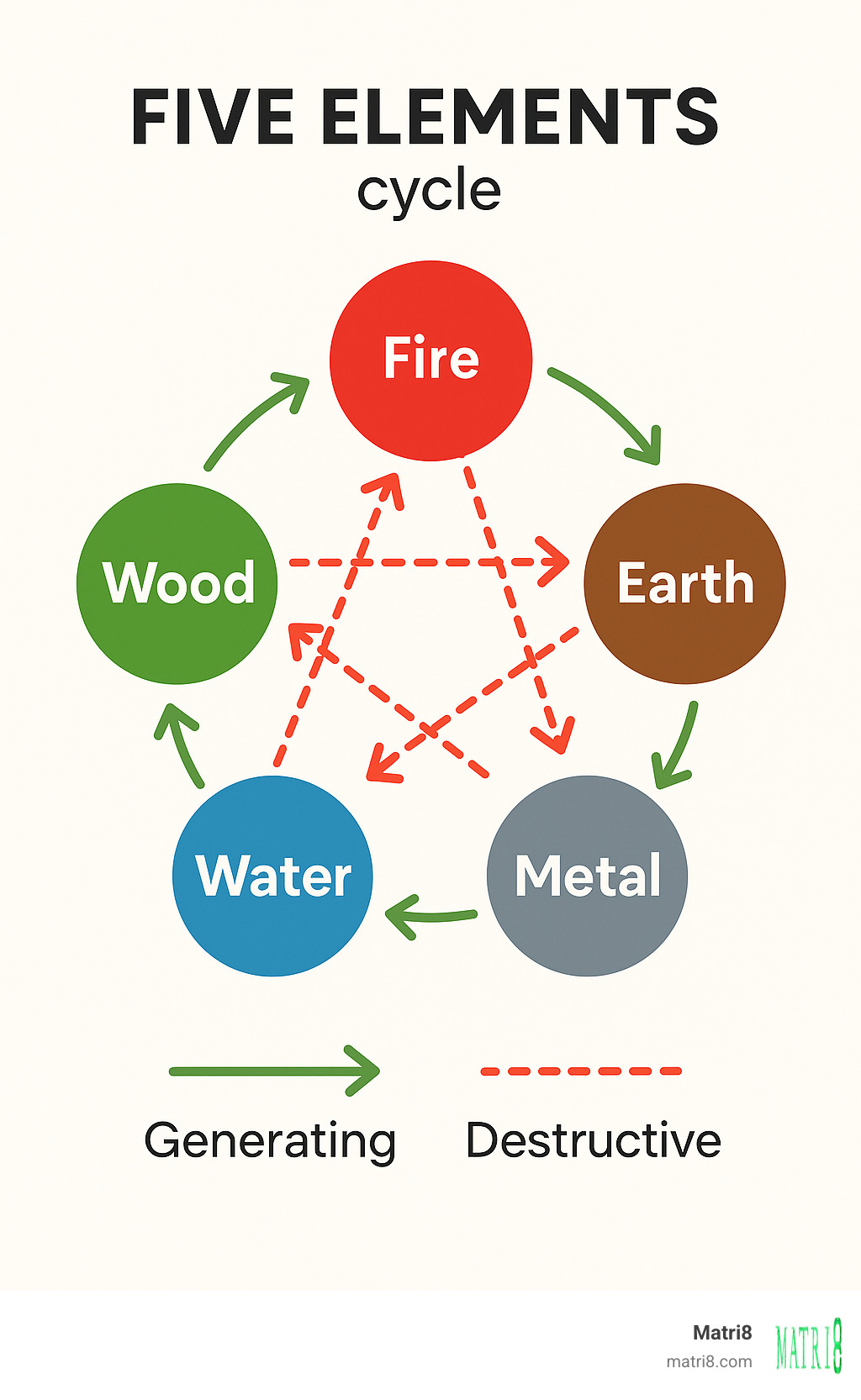
Five Elements & Yin-Yang
The Five Elements form the backbone of Chinese philosophy, and they add incredible depth to how Chinese zodiac animals influence your personality. Each element carries its own energy signature and connects to specific life areas.
Wood represents growth and creativity. If you’re born in a Wood year (ending in 4 or 5), you’re probably naturally artistic and flexible. Wood people tend to be the ones who adapt easily to change and come up with creative solutions. In the natural cycle, Wood feeds Fire – just like how creative energy can spark passion and action.
Fire symbolizes passion and change. Fire years end in 6 or 7, and these people often bring dynamic energy wherever they go. They’re the ones who light up a room and inspire others to take action. Fire creates Earth in the generating cycle, turning raw energy into something stable and lasting.
Earth brings stability and nurturing energy. Born in years ending in 8 or 9, Earth people are the reliable friends everyone counts on. They’re practical, grounded, and often become the foundation that others build upon. Earth produces Metal in the cycle, showing how solid foundations create structure and organization.
Metal represents precision and determination. If your year ends in 0 or 1, you probably have strong organizational skills and clear goals. Metal people are the planners and achievers who turn ideas into reality. Metal collects Water in the cycle, demonstrating how structure can channel and direct flow.
Water embodies wisdom and intuition. Water years end in 2 or 3, and these individuals often have deep insight and emotional intelligence. They’re adaptable like water itself, finding ways around obstacles rather than fighting them directly. Water nourishes Wood, completing the generating cycle and showing how wisdom feeds creativity.
The system also includes a destructive cycle that shows how elements can weaken each other: Wood depletes Earth, Earth absorbs Water, Water extinguishes Fire, Fire melts Metal, and Metal cuts Wood. Understanding these relationships helps explain personality conflicts and compatibility patterns.
Yin and Yang add another fascinating layer to Chinese zodiac animals. Even-numbered years carry Yang energy (active, outgoing, masculine), while odd-numbered years have Yin energy (receptive, introspective, feminine). This means two people born in the same animal year can have quite different personalities depending on whether it was a Yin or Yang year.
60-Year Sexagenary Cycle
Here’s where the math gets really interesting. The complete zodiac cycle takes exactly 60 years to repeat because you need all possible combinations: 12 animals × 5 elements = 60 unique pairings before the pattern starts over again.
Let’s follow the Rat through one complete element cycle to see how this works. A Yang Wood Rat born in 1984 has very different characteristics than a Yang Fire Rat from 1996, even though they’re both Rats born in Yang years. The 2008 Yang Earth Rat brings yet another energy combination, followed by the 2020 Yang Metal Rat, and eventually the 2032 Yang Water Rat. Only in 2044 do we return to another Yang Wood Rat – exactly 60 years later.
We’re currently living through the 78th complete cycle since ancient record-keeping began, spanning from 1984 to 2044. This system was so important to Chinese culture that it structured not just years, but also months, days, and even hours for making important decisions and understanding energy patterns.
The beauty of this system lies in its mathematical precision. Once you understand the decade pattern for one animal, you can calculate the element combinations for all the others. This predictable structure gave ancient astronomers confidence in the system and continues to provide reliable frameworks for modern practitioners working with Chinese zodiac animals and their deeper meanings.
Find Your Sign & Compatibility
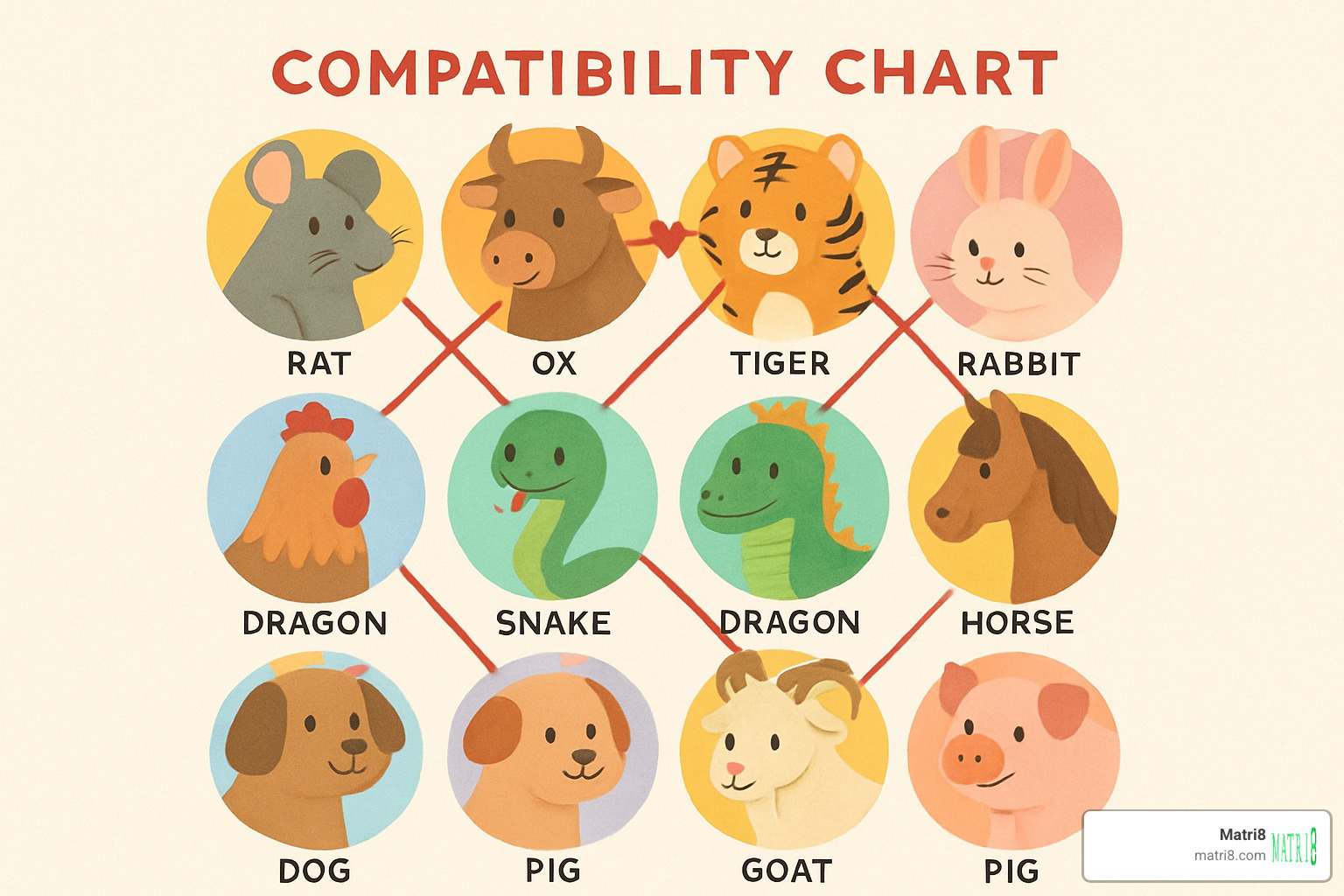
Finding your Chinese zodiac animals sign might seem straightforward – just look up your birth year, right? Well, here’s where many people get tripped up, especially if you were born during those tricky winter months.
The Chinese zodiac doesn’t follow our regular calendar. Instead, it follows the lunar calendar, which means Chinese New Year bounces around between late January and mid-February each year. If you were born before Chinese New Year in your birth year, you actually belong to the previous year’s animal sign.
Let’s say you were born in January 2000. You might assume you’re a Dragon (since 2000 was the Dragon year), but if your birthday fell before February 5th that year, you’re actually a Rabbit from 1999. This mix-up happens more often than you’d think!
Use a Chinese Zodiac Calculator
This is exactly why we created our Chinese Zodiac Calculator. It takes the guesswork out by automatically converting your birth date to the correct lunar calendar date. No more wondering if you’ve got the right animal or scratching your head over February birthdays.
But here’s something fascinating that most people don’t know – traditional Chinese astrology actually assigns you four different zodiac animals, not just one. Your year animal is how the world sees you, like your public face. Your month animal reflects your family relationships and how you connect with parents. Your day animal shows up in your adult personality and marriage relationships. Finally, your hour animal represents your deepest, most private self.
This explains why some people read their zodiac description and think, “That doesn’t sound like me at all.” You might actually relate more to your day or hour animal than your year animal. It’s like having layers of personality that reveal themselves in different situations.
We’ve noticed that people born in January and February are especially likely to have their sign wrong if they haven’t used a proper calculator. Don’t let a simple date mix-up throw off your entire understanding of your zodiac nature.
Best & Worst Matches
Chinese zodiac animals compatibility follows specific patterns that have been observed for centuries. It’s not just random – there’s actually a method to the madness.
The most harmonious relationships happen within what we call the Four Trines. The first trine includes Rat, Dragon, and Monkey – these are the charismatic go-getters who understand each other’s ambitious nature. They make fantastic business partners, though they can sometimes be a bit manipulative.
The second trine brings together Ox, Snake, and Rooster. These are your reliable, hardworking types who appreciate each other’s dedication. They might be a bit set in their ways, but they’re incredibly dependable for long-term relationships.
Tiger, Horse, and Dog form the third trine – the humanitarian heroes with strong moral compasses. They might argue sometimes, but they’re fighting for the same causes and understand each other’s need for justice.
The fourth trine consists of Rabbit, Goat, and Pig – the gentle, artistic souls who create beautiful, harmonious environments together. They can be indecisive, but they truly understand each other’s sensitive nature.
Now, direct opposites (animals that are six years apart) often clash initially. Think Rat versus Horse, or Tiger versus Monkey. But here’s the interesting part – these opposites can actually create incredibly dynamic relationships if both people understand and respect their differences. It’s like that saying about opposites attracting.
Elemental harmony also plays a huge role in compatibility. When your elements support each other in the generating cycle (like Wood feeding Fire, or Earth producing Metal), relationships tend to flow more naturally. When elements clash in the destructive cycle, you might need to work a bit harder to understand each other.
For deeper insights into how these compatibility patterns play out in real relationships and fortune-telling applications, check out our Chinese Zodiac Fortune Telling resources.
Legends, Culture & Modern Life
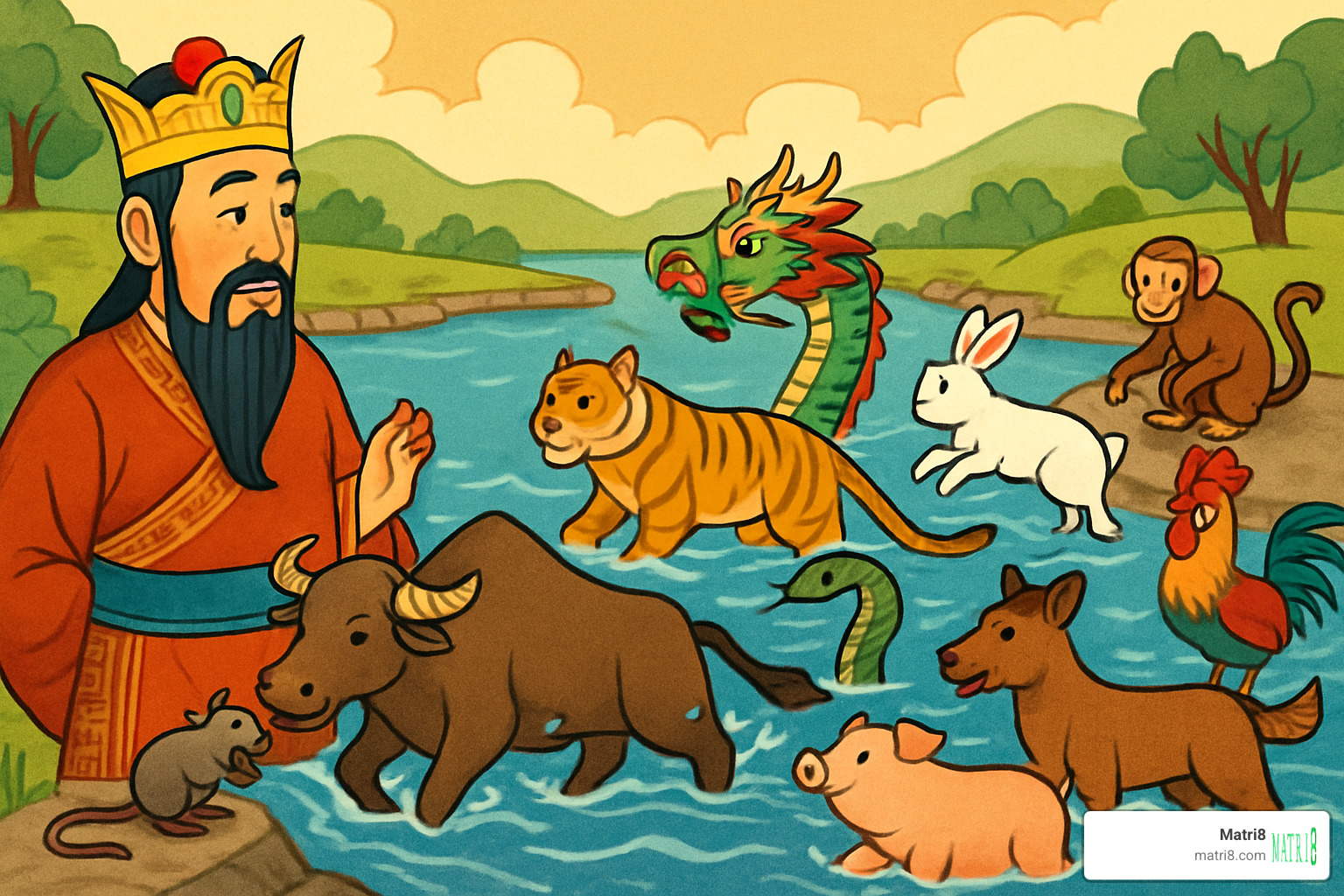
The Chinese zodiac animals aren’t just abstract symbols – they’re deeply woven into daily life, cultural celebrations, and modern decision-making across East Asia. Understanding these cultural connections helps explain why over 1.5 billion people still consult their zodiac for important life choices.
The zodiac influences everything from birth planning to career decisions. In China, birth rates can spike by up to 5% during auspicious years like the Dragon year, as families time pregnancies hoping for “Dragon babies” who are believed to have better fortune and success potential.
The Great Race Story
The most popular origin story explains both the animal order and why certain animals were excluded. According to legend, the Jade Emperor decided to create a calendar and invited all animals to participate in a great race across a swift river.
The clever Rat, knowing it couldn’t swim well, convinced the kind Ox to give it a ride. Just as they approached the finish line, the Rat jumped off the Ox’s back and secured first place. This explains why Rats and Oxen have a complex relationship – the Ox’s generosity was rewarded with second place, but it was also betrayed.
The Tiger arrived third, exhausted from fighting the river current. The Rabbit came fourth, having hopped across on stepping stones and floating logs. The mighty Dragon arrived fifth – surprising everyone. When asked why such a powerful creature didn’t win, the Dragon explained it had stopped to bring rain to drought-stricken villages and help other animals in need.
The Snake slithered in sixth, startling the Horse who was about to claim that position. The Horse settled for seventh place. The Goat, Monkey, and Rooster worked together to cross on a raft, arriving eighth, ninth, and tenth respectively.
The Dog came eleventh despite being an excellent swimmer – it had gotten distracted playing in the water. Finally, the Pig arrived twelfth, having stopped for a nap and a meal along the way.
But what about the Cat? In this version, the Rat had promised to wake the Cat for the race but “forgot” – explaining the eternal enmity between cats and rats. This is why cats didn’t make it into the zodiac, though Vietnamese culture includes the Cat instead of the Rabbit.
Ben Ming Nian Traditions
Your Chinese zodiac animals year – called Ben Ming Nian – occurs every 12 years and is traditionally considered challenging rather than lucky. It’s viewed as a reset of your cycle, often bringing heightened obstacles that require extra caution.
During Ben Ming Nian, people follow specific protective traditions:
Red Clothing: Wearing red underwear, socks, belts, or accessories daily is believed to ward off bad luck. Red represents good fortune and protection against evil spirits. Even modern, educated Chinese often follow this practice “just in case.”
Taisui Worship: People visit temples to worship Taisui, the god governing their zodiac year, asking for protection and guidance through the challenging period.
Conservative Decisions: Many avoid major life changes like marriage, job switches, or big investments during their Ben Ming Nian, preferring to wait for a more auspicious year.
Increased Vigilance: Extra attention to health, relationships, and finances, as these areas are believed to be more vulnerable during your zodiac year.
Interestingly, these beliefs affect modern behavior significantly. Our research shows that people often delay important decisions during their Ben Ming Nian, and some employers even consider zodiac compatibility when making hiring decisions.
For more specific guidance about navigating your zodiac year, check out our Chinese Zodiac Year resources.
The latest research shows that zodiac traditions continue evolving, blending ancient wisdom with modern life in fascinating ways.
Frequently Asked Questions about Chinese Zodiac Animals
How is my sign determined if I was born in January or February?
This is probably the most common confusion about Chinese zodiac animals – and for good reason! Your zodiac sign doesn’t follow the regular calendar year that starts on January 1st.
Instead, the Chinese zodiac follows the lunar calendar, which means Chinese New Year falls somewhere between January 21st and February 20th each year. The exact date changes because it’s based on moon phases, not our standard calendar.
Here’s where it gets tricky: if you were born before that year’s Chinese New Year, you actually belong to the previous year’s animal. So if you were born on January 15, 2000, you might think you’re a Dragon (since 2000 was a Dragon year). But Chinese New Year 2000 didn’t start until February 5th, which means you’re actually a Rabbit from 1999.
This mix-up affects millions of people worldwide, especially those with January and February birthdays. I always tell people to double-check using a proper zodiac calculator rather than guessing. Getting your sign wrong throws off everything – your personality reading, compatibility matches, even your Ben Ming Nian timing.
Some traditional astrologers use the “Start of Spring” date (usually around February 4th) instead of Chinese New Year, which adds another layer of complexity. When you’re not sure, it’s worth checking multiple sources to get the most widely accepted answer.
What is Ben Ming Nian and why is it considered tricky?
Ben Ming Nian is your Chinese zodiac animals year – the time when your birth animal comes around again in the 12-year cycle. You might expect this to be your luckiest year, but traditional Chinese culture sees it quite differently.
Instead of being fortunate, Ben Ming Nian is viewed as a challenging “hurdle” year that requires extra caution and protection. The belief is that during your zodiac year, you’re more vulnerable to negative influences and setbacks.
Think of it as a cosmic reset button. Old patterns in your life break down before new ones can emerge, creating a period of instability and uncertainty. It’s like your personal energy is out of sync with the universe’s rhythm.
That’s why people follow specific protective traditions during their Ben Ming Nian. Wearing red clothing (especially red underwear and socks) is the most common practice – red represents good fortune and protection against evil spirits. Many people also avoid major life changes like getting married, switching jobs, or making big investments during this year.
Visiting temples to worship Taisui – the god governing your zodiac year – is another traditional way to ask for protection and guidance through the challenging period. People also tend to be extra careful with their health, relationships, and finances.
What’s fascinating is that even modern, educated Chinese people often follow these traditions, treating them as cultural insurance. The psychological effect can be real too – heightened awareness during Ben Ming Nian sometimes does help people avoid problems through increased caution.
Which Chinese zodiac animals are thought to be the luckiest or unluckiest?
The Dragon consistently tops the “luckiest” lists and for good reason – it’s the only mythical animal in the zodiac and represents power, success, and imperial authority. Birth rates actually spike during Dragon years because families desperately want Dragon babies, believing they’ll achieve greater success in life.
Other traditionally lucky signs include the Snake (wise and intuitive), Pig (generous and prosperous), Rat (clever and resourceful), and Tiger (brave and powerful). These animals are associated with wealth, intelligence, and strong leadership qualities.
On the flip side, the Goat unfortunately gets labeled as the unluckiest sign due to an old folk saying: “10 Goats, 9 incomplete.” This cruel superstition suggests that 9 out of 10 people born in Goat years will face inadequacy or hardship in life. The belief is so strong that some families actively avoid having children during Goat years.
But here’s the thing – I believe these luck rankings miss the bigger picture. Each Chinese zodiac animals sign has both advantages and challenges. Success depends much more on understanding and working with your animal’s natural traits than on whether it’s traditionally considered “lucky.”
Take Goats, for example. Yes, they’re labeled “unlucky,” but they’re also gentle, artistic, and deeply compassionate. These qualities can lead to incredible fulfillment in creative fields, counseling, or any profession that helps others. The “unlucky” label reflects outdated social values that prized aggression and competition over kindness and creativity.
Rather than worrying about whether your sign is supposedly lucky or unlucky, focus on understanding your animal’s unique strengths and how to use them effectively in your relationships and career choices. That’s where the real value of the zodiac system lies.
Conclusion
Your journey with chinese zodiac animals goes far beyond simple personality descriptions – it opens a door to ancient wisdom that has helped people steer life’s complexities for over 2,000 years.
Think about it: whether you’re a resourceful Rat plotting your next career move, a steady Ox building something that will last, or a bold Dragon ready to chase your biggest dreams, understanding your zodiac animal gives you a roadmap for making better choices. It’s like having a cosmic GPS for your personal journey.
The beauty of this system lies in its depth. The 12 animals, 5 elements, and yin-yang principles create layers of insight that go way beyond “you’re a Tiger, so you’re brave.” Your complete zodiac profile reveals why some relationships click instantly while others feel like work, why certain career paths energize you while others drain you, and even why some years feel easier than others.
What makes chinese zodiac animals so practical is how they connect to real life. This isn’t about vague predictions – it’s about understanding your natural patterns and working with them instead of against them. When you know your elemental nature and compatibility patterns, you can make more informed decisions about everything from business partnerships to romantic relationships.
At Matri8, we’ve finded that combining zodiac insights with numerology creates an even richer picture of who you are. Your zodiac animal is like one instrument in a cosmic orchestra – important on its own, but even more powerful when it harmonizes with your other numbers and astrological influences.
Ready to dive deeper into what 2025 holds for you? The Year of the Wood Snake is approaching, and each zodiac animal will experience it differently. Our Chinese Zodiac Sign for 2025 guide shows you exactly what to expect and how to make the most of the coming year’s energy.
Your chinese zodiac animals aren’t meant to box you in – they’re meant to set you free. When you understand your natural strengths and challenges, you can stop fighting your nature and start dancing with it. That’s when life gets really interesting.
Your zodiac animal is your starting point, not your destination. Use this ancient wisdom as a compass for your modern journey, and watch how it transforms your understanding of yourself and your place in the world.